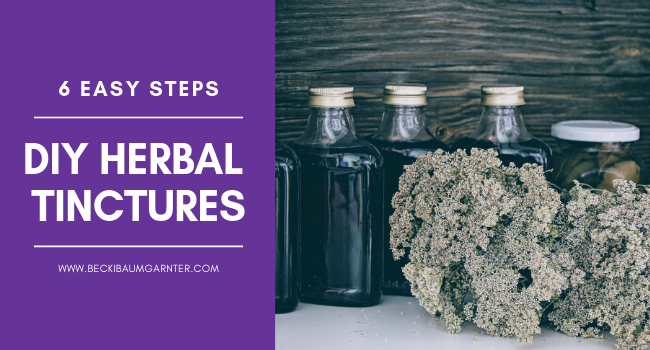Have you been experimenting with growing herbs in your garden or maybe taking a few classes on wildcrafting and gathering herbs?
If so, now is the time to take your experience one step further and learn how to store your harvest!
Making an herbal tincture is not as difficult as it sounds, and can be done quickly and easily in your own home.
You Will Need:
- a pint-sized glass jar with a tight-fitting lid
- approximately 2 cups of fresh plant material
- approximately 2 cups of 80 to 100-proof vodka, brandy or rum
Step 1: Gather, Sort & Clean Your Plants
After gathering your plants, you will need to sort and clean them.
Toss out any damaged, yellow, moldy or rotten pieces.
Chopping the herbs at this time will open the cell walls to alcohol.
( I like to run the plants through the blender with a portion of the alcohol that I will be using as the menstruum.)
Step 2: Put The Herbs & Alcohol in a Jar
Place the plant material in a glass jar or container leaving approximately one inch at the top.
Completely cover the herbs with the alcohol you have chosen.
Use a knife to skim around the inside edges of the jar and release any trapped air bubbles.
Then, add some more alcohol.
Add enough to cover all of the plant material.
Screw on the lid and shake well for approximately one minute.
Step 3: Label the Jar
Make sure you label and date your tincture.
You may also want to note on the label where you gathered the herbs, as well as the weather and seasonal conditions.
You can use this information at a later date to figure out the best times for gathering each particular herb.
Step 4: Store in a Cool, Dark Place
Store the jar of herbs in a cool, dark area (most importantly out of direct sunlight) for six weeks.
Shake the jar every few days and check to make sure that all of the plant material remains covered with alcohol.
(Add more alcohol if a portion of the plant material is not covered.)
Step 5: Strain the Mixture
After six weeks, strain and press the liquid through a piece of cheesecloth into a bowl or pitcher.
The bowl or pitcher should be glass or stainless steel, as other materials may react with the herbs.
Leave the plant material behind in the jar or on a cheesecloth.
After all of the liquid has been poured, spoon out all the herbs onto the cheesecloth.
Wrap the cheesecloth around the herbs and wring out any additional tincture into the bowl or pitcher.
Your tincture is now completed!
Step 6: Store Your Tincture
Pour into a glass bottle of the appropriate size and label.
Dark colored bottles are best.
Make sure to store it in a cool dark place!
My Favorite Herb Books:
- Jude’s Herbal Home Remedies: Natural Health, Beauty & Home-Care Secrets (Living With Nature Series)
- All About Herbs
- Rosemary Gladstar’s Herbal Recipes for Vibrant Health: 175 Teas, Tonics, Oils, Salves, Tinctures, and Other Natural Remedies for the Entire Family
- Secrets of the Chinese Herbalists
- Herbs: An Illustrated Guide
